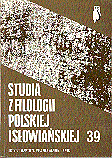Konfrontacja leksykonów w językach genetycznie i typologicznie bliskich
Comparison of lexicons of genetically and typologically related languages
Author(s): Zbigniew GreńSubject(s): Language and Literature Studies
Published by: Instytut Slawistyki Polskiej Akademii Nauk
Summary/Abstract: The aim of this paper is to analyse some aspects of comparison of lexicons of genetically and typologically related languages. The analysis has been made on Polish and Czech lexical material. There are some aspects of diversity in the similar languages. The differences within lexical structures are not remarkable. Usually there appear only in details, e.g. in Czech there is a lack of literary lexical equivalent of Polish colour name: granatowy in opposition to (ciemno)niebieski – in Czech (tmavo)modrý stands for both these shades. The differences in distribution of similar lexical elements are more visible, e.g. Cz. červený : rudý vs. Pol. czerwony : rudy, e.g. Cz. Červený kříž, Rudá armáda vs. Pol. Czerwony Krzyż, Armia Czerwona. The most common differences are in collocation of lexical units, analysed in whole lexical fields, e.g. Cz. modrý, blankytný, Pol. granatowy, niebieski, modry, błękitny, siny. Such type of analysis is possible thanks to lexical bases and dictionaries which note collocation of words, e.g. (used in the paper) Český národní korpus and Słownictwo pism Stefana Żeromskiego.
Journal: Studia z Filologii Polskiej i Słowiańskiej
- Issue Year: 2004
- Issue No: 39
- Page Range: 179-196
- Page Count: 18
- Language: Polish

